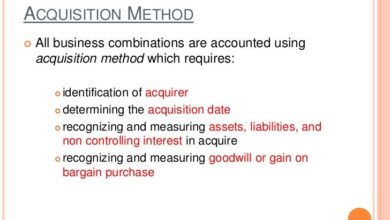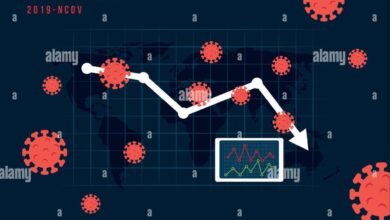
UK FRC Consolidates Coronavirus Guidance for Boards
UK FRC consolidates coronavirus guidance for boards, offering a comprehensive framework for navigating the pandemic’s financial reporting challenges. This detailed guidance, developed over several phases, aims to provide clarity and consistency for UK companies across various sectors. From initial responses to ongoing adjustments, the FRC has diligently addressed the unique financial reporting complexities presented by the pandemic, considering the impacts on everything from hospitality to manufacturing.
The guidance meticulously details the key principles and accounting treatments, including methodologies for addressing uncertain economic conditions. A thorough analysis of its effectiveness, compared to other jurisdictions, is also included, along with potential areas for improvement and the use of case studies. The document anticipates long-term implications and trends in financial reporting, offering insights into the FRC’s potential role in future economic crises, and how this guidance may influence future accounting standards.
Background of UK FRC Coronavirus Guidance
The UK Financial Reporting Council (FRC) plays a crucial role in upholding the integrity and quality of financial reporting within the UK. Established in 2001, it’s an independent body responsible for setting and maintaining high standards for financial reporting and auditing, thereby fostering trust and confidence in the capital markets. Their work ensures transparency and accountability for companies, benefiting investors and the wider economy.The FRC’s mandate extends beyond typical regulatory oversight.
Recognizing the unprecedented nature of the COVID-19 pandemic, the FRC adapted its approach to provide timely and relevant guidance for businesses navigating the crisis. This adaptation involved a careful consideration of the evolving impacts of the pandemic on financial reporting practices and the potential for reporting difficulties.
Evolution of Coronavirus-Related Guidance
The FRC’s response to the coronavirus crisis evolved through distinct phases, reflecting the dynamic nature of the pandemic. Initially, the focus was on providing immediate support and clarifying the implications of the crisis on financial reporting obligations. Subsequently, the guidance adapted to account for ongoing challenges and the evolving financial landscape, demonstrating a commitment to ongoing support.
Key Motivations Behind FRC Actions
The FRC’s actions were driven by several key motivations. Maintaining market confidence and ensuring the reliability of financial information were paramount. Understanding the unique challenges faced by businesses during the pandemic, and adapting the regulatory framework accordingly, was also crucial. Further, ensuring consistent application of financial reporting standards across the board was a primary concern. This was essential for maintaining fairness and comparability of financial information.
Initial Response Phase (2020)
The initial FRC response emphasized the importance of transparency and clear communication regarding the impact of the pandemic on financial reporting. Companies were encouraged to disclose material effects of the pandemic on their financial position and performance. This emphasis on transparency was crucial in maintaining market confidence and allowing investors to assess the impact of the crisis.
Ongoing Adjustments (2021-Present)
The FRC’s guidance evolved beyond the initial response. Recognizing the long-term implications of the pandemic, the FRC issued updated guidance to address evolving issues such as supply chain disruptions, workforce changes, and the economic fallout. This adaptability was crucial for companies to navigate the challenges and to provide accurate financial reporting.
Table of Key Updates to FRC Guidance
| Date | Key Update |
|---|---|
| April 2020 | Initial guidance on disclosing material impacts of the pandemic on financial statements. |
| June 2020 | Clarification on the application of existing accounting standards to COVID-19 related issues. |
| September 2021 | Guidance on addressing potential future uncertainties related to the pandemic. |
| December 2022 | Updated guidance on the impact of supply chain disruptions and workforce changes. |
Impact on Financial Reporting Practices

The UK FRC’s coronavirus guidance significantly impacted financial reporting practices for UK companies, forcing them to adapt to unprecedented circumstances. The guidance aimed to provide clarity and consistency amidst the economic disruption caused by the pandemic, while ensuring the integrity of financial statements. This required careful consideration of the specific challenges faced by different sectors, particularly those heavily affected by lockdowns and restrictions.The guidance’s influence extended beyond simply providing a framework for reporting; it underscored the importance of transparency and flexibility in financial reporting during times of crisis.
This adaptability was critical to reflecting the true financial position and performance of companies, particularly those experiencing substantial shifts in revenue, expenses, and cash flow.
Impact on Different Sectors
The pandemic’s impact varied across sectors. Hospitality and retail, for instance, experienced substantial declines in revenue as lockdowns and social distancing measures restricted operations. This led to increased provisions for doubtful debts and impairment of assets, which were clearly reflected in their financial statements. Conversely, sectors like healthcare and technology saw increased demand and revenue, requiring careful consideration of future growth and profitability.
Manufacturing also faced disruptions, including supply chain issues and labor shortages, impacting production and costing. The FRC’s guidance aimed to help companies in all sectors report accurately and transparently, recognizing the distinct challenges each faced.
Key Financial Reporting Challenges
Several key financial reporting challenges emerged during the pandemic, as highlighted by the guidance. Companies faced difficulties in estimating future performance, especially with the uncertainty surrounding the duration and severity of the pandemic’s impact. Furthermore, determining the appropriate level of provisions for potential losses and impairments posed a significant challenge. The guidance emphasized the importance of strong internal controls and accurate assessments, and how those factors were needed for financial reporting accuracy.
The impact on inventory valuation and revenue recognition was also significant, with specific guidance provided for these areas to ensure consistency and comparability across companies.
FRC’s Approach to Consistent Application
The FRC addressed the need for consistent application of the guidance across diverse industries through several key strategies. One crucial element was the provision of detailed examples and scenarios in the guidance, helping companies in various sectors understand how to apply the principles to their specific situations. This approach aimed to minimize inconsistencies and improve the comparability of financial statements across different industries.
Regular updates and clarifications were also issued to address emerging issues and provide further support to companies navigating the complex reporting landscape.
Materiality and Estimations in Financial Statements
The guidance emphasized the importance of considering materiality when assessing the impact of the pandemic on financial statements. This meant that companies needed to focus on items that had a significant impact on their overall financial position and performance. The guidance also provided specific guidance on how to approach estimations in financial statements, such as those related to provisions for doubtful debts, impairment of assets, and future revenue projections.
The guidance encouraged companies to document their methodologies and assumptions clearly, allowing for transparency and enabling auditors to assess the validity of the estimations. For example, if a company had to estimate losses due to a sudden downturn in sales, the guidance provided a framework for documenting the assumptions made about future sales and the reasons for the chosen estimation method.
Companies were encouraged to use a combination of qualitative and quantitative factors when making these estimations, reflecting the dynamic nature of the pandemic’s impact.
Key Elements of the Consolidated Guidance
The UK FRC’s consolidated coronavirus guidance provides a crucial framework for financial reporting during uncertain economic times. It aims to ensure consistency and comparability in financial statements, acknowledging the unique challenges businesses faced due to the pandemic. This guidance streamlines the application of existing accounting standards, while addressing specific issues arising from the pandemic’s impact.The key principles behind the guidance are grounded in maintaining the integrity and transparency of financial reporting.
It emphasizes the importance of applying judgment and professional skepticism in assessing the impact of the pandemic on individual entities. The guidance acknowledges the dynamic nature of the situation and encourages boards to adopt a forward-looking approach, proactively addressing potential risks and opportunities.
Summary of the Consolidated Guidance Document
The consolidated guidance document offers a comprehensive overview of how to apply existing accounting standards in the context of the pandemic’s economic fallout. It synthesizes various previous guidance into a single, cohesive resource, making it easier for preparers to understand and apply the necessary adjustments. It also provides illustrative examples and scenarios to aid in practical application.
Key Principles Underlying the Guidance
The guidance rests on several fundamental principles: Materiality, prudence, and relevance are crucial considerations. The guidance also stresses the importance of providing clear and concise disclosures. Boards are expected to exercise professional judgment in applying the guidance, recognizing that the pandemic’s impact varied significantly across different sectors and entities.
Examples of Specific Accounting Treatments Addressed
The guidance tackles various accounting treatments impacted by the pandemic. For example, it clarifies the accounting for revenue recognition in situations involving significant disruptions to business operations. It also provides guidance on the impairment of assets, including goodwill and property, plant, and equipment, in light of changing economic conditions. Further, the guidance explicitly addresses the accounting for provisions related to potential future losses.
Methodologies Used to Address Uncertain Economic Conditions
To navigate uncertainty, the guidance advocates for a forward-looking approach. It encourages boards to assess the potential impact of the pandemic on future performance and financial position. It stresses the importance of using available information, including forecasts and projections, to form realistic estimates. For example, businesses should factor in any likely changes to future sales, production, and operating expenses, as well as potential risks and opportunities.
Qualitative factors are also given considerable weight.
Table Outlining Key Areas Covered
| Key Area | Specific Accounting Policies |
|---|---|
| Revenue Recognition | Adjustments for contract modifications, cancellations, or deferrals. |
| Impairment of Assets | Assessing the impact of pandemic-related factors on asset values (e.g., goodwill, property, plant, and equipment). |
| Provisions | Recognizing provisions for potential future losses, including those related to customer defaults or supply chain disruptions. |
| Inventory | Accounting for changes in inventory levels and obsolescence risk due to the pandemic. |
| Leases | Clarification on the application of IFRS 16 in the context of pandemic-related lease modifications. |
Analysis of Guidance Effectiveness
The UK FRC’s coronavirus guidance, while well-intentioned, needs a critical assessment of its effectiveness in navigating the unique financial reporting challenges the pandemic presented. This evaluation considers the specific challenges faced by companies, compares the FRC’s approach with international standards, and assesses the potential impact on investor confidence, highlighting areas for improvement. Case studies provide a practical application of the guidance’s influence on real-world financial reporting.This analysis delves into the practical application of the guidance, considering its impact on various company types and sizes, and the implications for investor confidence.
Find out about how global cfo survey rebuild revenue streams can deliver the best answers for your issues.
The effectiveness of the guidance will be evaluated against the backdrop of the specific financial reporting difficulties companies faced due to the pandemic.
Effectiveness in Addressing Pandemic-Related Financial Reporting Challenges
The UK FRC’s guidance aimed to assist companies in adapting their financial reporting to the unprecedented economic conditions. This included providing flexibility in applying accounting standards and recognizing the unique circumstances faced by businesses. However, the effectiveness of this flexibility is dependent on its practical application and the degree to which companies actually utilized the guidance. The impact on different sectors, such as hospitality or retail, will likely vary significantly, reflecting the unique disruptions each experienced.
You also can understand valuable knowledge by exploring cima ethics confidentiality rules.
Comparison with Other Jurisdictions
The UK FRC’s approach to coronavirus-related financial reporting guidance was compared to those of other major jurisdictions, such as the US and EU. The FRC’s focus on providing practical guidance, while acknowledging the need for flexibility, contrasted with some approaches that emphasized a stricter, more standardized approach. This comparative analysis allows for an understanding of the diverse strategies used across different jurisdictions.
Different jurisdictions responded to the challenges of the pandemic in various ways, impacting financial reporting practices in those areas. The US, for instance, may have emphasized a more formal, prescriptive approach, while the EU could have focused on harmonization across member states. This comparative study illuminates the effectiveness and scope of each approach.
Potential Impact on Investor Confidence
The FRC’s guidance aimed to maintain transparency and comparability in financial reporting during a period of significant uncertainty. The effectiveness of the guidance in fostering investor confidence is crucial. Investors rely on accurate and consistent financial information to make informed decisions. The guidance’s success in achieving this goal will depend on its clear communication, consistent application, and perceived neutrality.
Discover more by delving into positive outlook financial services work in europe further.
This will likely be measured by investor sentiment and market reaction to companies’ reported financial performance, demonstrating the influence of the guidance.
Areas for Improvement in the Guidance
The guidance could potentially be enhanced by providing more specific examples of how to apply the flexibility in various situations. A more detailed explanation of how to use alternative accounting treatments, particularly for companies facing severe disruptions, could improve its practical utility. Addressing the specific needs of smaller businesses, which often have limited access to accounting expertise, could be a critical area for improvement.
Greater clarity and more precise language could ensure that companies understand the expectations of the guidance, leading to greater consistency and confidence.
Case Studies Illustrating the Guidance’s Impact
Analyzing specific case studies of companies that applied the guidance can offer insights into its effectiveness. For example, a case study of a retailer facing significant supply chain disruptions due to lockdowns would demonstrate how the guidance assisted in reporting these impacts accurately. This practical application reveals the effectiveness of the guidance, highlighting the specific areas where it aided in the reporting of unique circumstances.
By examining multiple companies, a more comprehensive understanding of the impact on financial reporting can be obtained. These case studies can provide insights into the guidance’s effectiveness across different industries and company sizes. For instance, a hospitality company impacted by travel restrictions would offer a contrasting perspective, showcasing how the guidance addressed unique operational and financial challenges in different sectors.
Future Implications and Trends: Uk Frc Consolidates Coronavirus Guidance For Boards
The UK FRC’s coronavirus guidance has undeniably left a lasting mark on financial reporting practices. Moving forward, its influence will likely be felt across various aspects of the industry, from reporting methodologies to the very structure of accounting standards. The pandemic’s disruption highlighted vulnerabilities in existing systems, prompting a critical reassessment of how companies present their financial health.The guidance’s lasting impact will extend beyond the immediate crisis, reshaping the landscape of financial reporting to better address future uncertainties and economic shocks.
This adaptability will be crucial in maintaining trust and transparency in financial markets. The FRC’s response to the pandemic sets a precedent for how regulatory bodies can react to future crises, with lessons learned shaping their approach to risk management and market stability.
Long-Term Implications on Financial Reporting Practices
The guidance’s long-term implications include a heightened focus on the qualitative aspects of financial reporting. This emphasis will shift the focus from simply presenting figures to ensuring that the information presented accurately reflects the company’s underlying performance and resilience. Increased scrutiny on disclosures related to business continuity and risk management will become standard practice, mirroring the lessons learned during the pandemic.
Companies will need to be more proactive in communicating potential disruptions and their impact on financial forecasts.
Future Trends in Financial Reporting
Several trends are expected to emerge in financial reporting. One key trend will be a greater emphasis on forward-looking information, including scenarios and projections, to help stakeholders better understand the potential impact of various future events on the company’s performance. Another is the growing use of data analytics and technology to enhance the efficiency and accuracy of financial reporting processes.
Real-time reporting and predictive modelling will gain traction as crucial tools for informed decision-making. For example, companies might incorporate predictive models for revenue projections based on historical data and current market conditions, providing more comprehensive insights.
FRC’s Potential Role in Adapting to Future Economic Crises
The FRC’s role in adapting to future economic crises will be critical. This includes proactively engaging with industry stakeholders to identify potential risks and develop adaptable reporting frameworks. The FRC could play a key role in establishing best practices for scenario planning and stress testing, ensuring that financial reports provide a more complete picture of a company’s resilience in challenging economic environments.
They could potentially collaborate with international bodies to create globally recognized standards for crisis-related disclosures.
Influence on Future Accounting Standards
The guidance may influence the development of future accounting standards by highlighting the need for greater flexibility and adaptability. The pandemic demonstrated the limitations of rigid accounting standards in rapidly changing circumstances. Future standards will likely incorporate more flexible frameworks, enabling companies to better reflect the impact of unforeseen events on their financial statements. The IFRS (International Financial Reporting Standards) framework might adopt a more flexible approach, allowing for adjustments in specific cases based on the nature of the crisis and its impact on the company.
Potential Long-Term Effects on Stakeholders, Uk frc consolidates coronavirus guidance for boards
| Stakeholder | Potential Positive Effects | Potential Negative Effects |
|---|---|---|
| Investors | Enhanced transparency and better understanding of company resilience. | Potential for increased complexity in financial reporting and analysis. |
| Creditors | Improved assessment of company risk and financial stability. | Potential delays in receiving accurate financial information. |
| Companies | Increased understanding of their own vulnerabilities and resilience. | Increased reporting burden and potential costs associated with enhanced disclosures. |
| Regulators | Greater insight into market vulnerabilities and opportunities for improvement. | Potential need for increased resources to oversee and enforce updated standards. |
Illustrative Scenarios and Examples

The UK FRC’s coronavirus guidance provides a framework for companies to adapt their financial reporting practices during uncertain times. Illustrative scenarios help to clarify how the guidance is applied in various circumstances, highlighting its flexibility and nuanced approach. This section explores how the guidance tackles the complexities of reporting during periods of economic volatility.
Impact of Supply Chain Disruptions
The guidance acknowledges the potential for supply chain disruptions to significantly impact a company’s ability to fulfill orders and maintain profitability. A manufacturing company, for example, experiencing substantial delays in procuring raw materials due to a global pandemic, might need to adjust its financial projections and disclose this in its financial statements. The guidance emphasizes the importance of a company’s assessment of the materiality of the disruption, its potential duration, and the resulting impact on revenue and expenses.
Accounting for Government Grants
Government grants, often provided in response to economic crises, can substantially affect a company’s financial performance. The guidance provides specific accounting treatment for such grants, highlighting the importance of distinguishing between grants intended to cover specific costs and those designed to support general operations. For instance, a grant to cover the costs of adapting a manufacturing facility to meet new safety regulations would be recognized differently than a grant to assist with general operating expenses.
This distinction is crucial for accurately reflecting the grant’s impact on the company’s financial position.
Recognition of Impairment of Assets
The guidance Artikels the process for recognizing impairment of assets when a company faces a significant downturn. Consider a retailer facing a sharp decline in consumer confidence and sales. The guidance would direct the company to assess the recoverable amount of its inventory and property, plant, and equipment. If the recoverable amount is lower than the carrying amount, the company must recognize an impairment loss.
This process is crucial for providing a realistic and accurate reflection of the company’s financial health.
Table: Illustrative Scenarios and Accounting Treatments
| Scenario | Accounting Treatment under Guidance |
|---|---|
| Significant supply chain disruption impacting raw material procurement | Assess materiality, duration, and impact on revenue and expenses. Disclose in financial statements, potentially adjusting financial projections. |
| Government grant to cover specific costs (e.g., adapting to safety regulations) | Recognize the grant as a reduction in the cost of the specific asset or expense. |
| Government grant to support general operations | Recognize the grant as revenue over the period of benefit, or as deferred income depending on the terms of the grant. |
| Decline in consumer confidence and sales leading to impairment of inventory | Assess the recoverable amount of inventory. If lower than carrying amount, recognize an impairment loss. |
Mitigation of Potential Risks
Companies can mitigate risks by implementing robust internal controls and procedures for evaluating the impact of external events. This includes establishing clear communication channels for disseminating information about emerging risks and regularly reviewing financial forecasts to reflect any changes in circumstances. Thorough documentation of the rationale behind accounting judgments and estimates is also crucial for demonstrating transparency and accountability.
Addressing Uncertainty and Judgment
The guidance acknowledges the inherent uncertainty in financial reporting, particularly during times of crisis. It emphasizes the importance of applying professional judgment, considering the most likely outcomes, and disclosing any significant uncertainties and assumptions. This transparent approach allows stakeholders to better understand the company’s position and assess the potential impact of future events.
Closing Summary
In conclusion, the UK FRC’s consolidated coronavirus guidance for boards provides a robust framework for navigating the financial reporting landscape during the pandemic. By addressing key challenges, offering clear principles, and anticipating future implications, the guidance seeks to support UK companies in maintaining financial transparency and investor confidence. The detailed analysis and illustrative examples presented within the document are valuable tools for understanding and implementing the guidance effectively.





